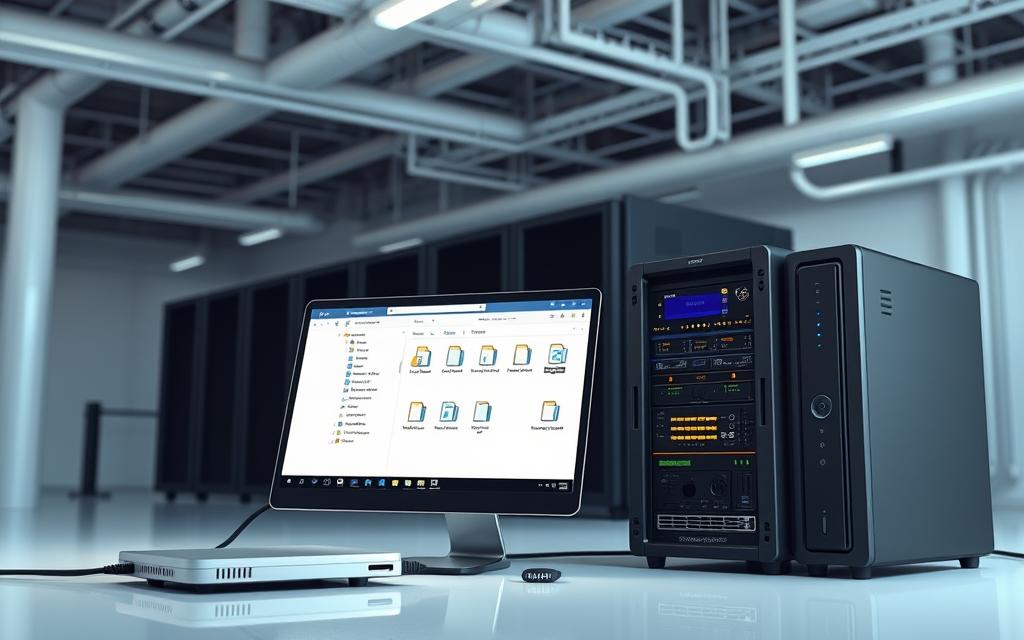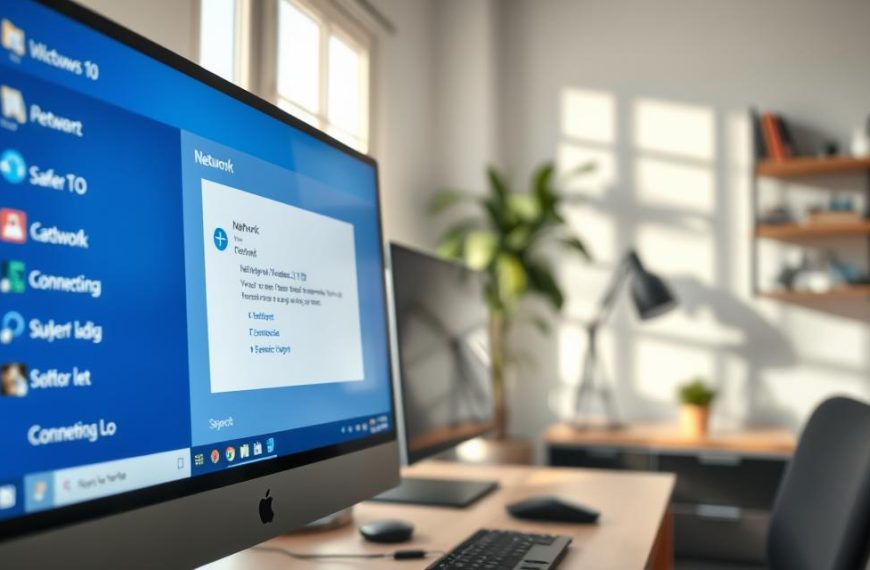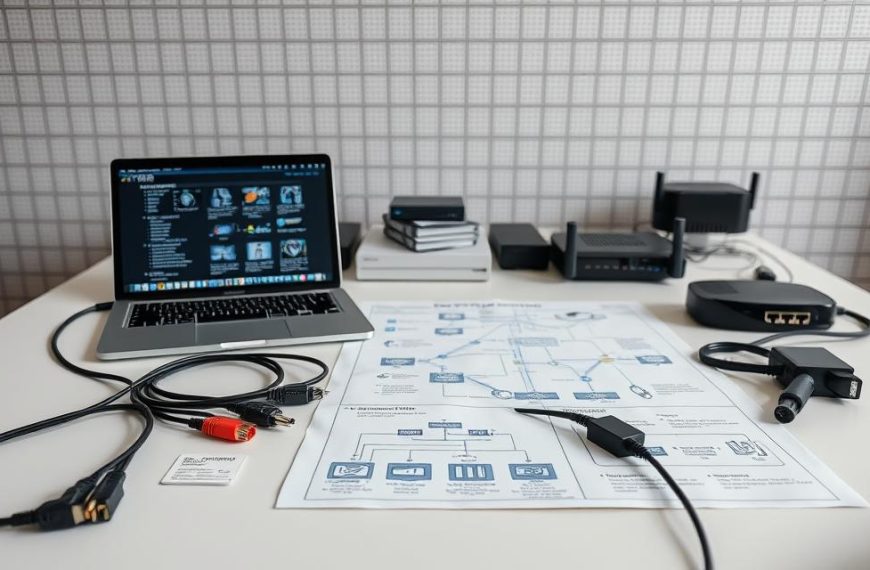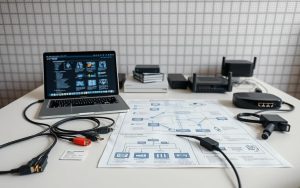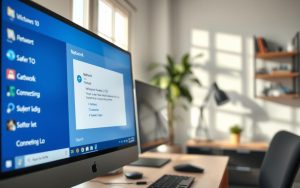Network file sharing has transformed how we collaborate and access digital resources. Users can now retrieve files from other computers on the same network. This enhances productivity and communication1.
Remote file access has become vital for businesses and individuals2. About 80% of users rely on Windows File Explorer for shared files1. On macOS, 75% use Finder for shared folder access1.
Navigating networked computers can be tricky. Network discovery is often disabled by default. Users must manually enable settings1. About 68% of users might miss network discovery configurations, causing connectivity issues1.
Security is crucial in network file sharing. Around 55% of users use password protection for shared folders1. For more guidance, explore detailed file access strategies.
Over 468,874 support page views show the need for clear network file sharing guidance1. This intro helps understand accessing files across networked computer systems.
Understanding Network File Sharing Basics
Network file sharing lets users access and swap digital files across connected computers. This technology enables smooth teamwork and resource management in work and home settings3.
Grasping file sharing basics is key. Users can set specific access levels for shared folders. These range from read-only to full access permissions.
Network admins can define four access levels:
- Read & Write
- Read Only
- Write Only (Drop Box)
- No Access
Network Discovery and Sharing Settings
Network discovery is vital for successful file-sharing connections. Proper sharing settings ensure secure and efficient data transmission4.
Key points to consider include:
- Verifying network connectivity
- Configuring appropriate firewall settings
- Setting up domain trust relationships
- Managing user access permissions
Basic Requirements for Network Access
To set up network file sharing, users must meet some key requirements. File sharing must be on in system settings3.
Admins control access permissions. Critical elements include:
- Stable network infrastructure
- Properly configured sharing settings
- Appropriate user authentication
- Robust security protocols
Knowing these settings helps create safe, efficient file-sharing spaces. This allows for smooth digital teamwork4.
How to Access Files on Another Computer on My Network
Windows file sharing lets you access network files easily. You’ll need proper network settings and connectivity. Let’s explore the key steps to make this happen.
- Open File Explorer on your computer
- Type \\computername or \\IP address in the address bar
- Enter network credentials when prompted
Network credentials ensure secure file access. Users can choose from Read & Write, Read Only, or Write Only access levels5. Admins can set these permissions to keep systems safe6.
Here are some tips to boost security:
- Use VPN for remote access6
- Enable SMB encrypted connections
- Limit guest user access
OneDrive and other cloud storage services offer different ways to share files. They provide handy online backups and sync across devices6.
Advanced Methods for Remote File Access
Professionals need flexible solutions for accessing files remotely. The digital world offers many sophisticated approaches to secure file management. These methods work across different networks and devices7.

Remote file access requires understanding various technological options. These options cater to different needs and security requirements.
VPN Solutions for Secure Remote Connectivity
VPN access provides a robust method for securely connecting to remote networks. Over 70% of employees now recognise the importance of remote file access7.
VPN servers create encrypted tunnels for safe file transfers. Dedicated remote access platforms can help implement this technology.
- Establish encrypted network connections
- Protect sensitive corporate data
- Enable seamless remote working
Cloud Storage Integration Strategies
Cloud storage services have transformed remote file management. About 60% of organisations now use platforms like Google Workspace and Microsoft OneDrive7.
These services typically offer:
- Free storage up to 15 GB for individual users
- Scalable enterprise solutions
- Multi-device synchronisation
Network-Attached Storage (NAS) Solutions
NAS devices provide centralised storage accessible from multiple locations. These dedicated systems allow organisations to create private cloud-like environments7.
NAS offers enhanced control over file access. Careful setup ensures secure remote connectivity while maintaining strict access protocols.
Using these advanced remote access methods can boost productivity by up to 30%7. Multi-factor authentication can reduce unauthorised access risks by 80%7.
Setting Up Shared Folders and Permissions
Managing shared folders and file permissions is vital for network security. Proper configuration protects sensitive data while allowing necessary access8.
Careful setup ensures an efficient network environment. Network sharing requires thoughtful planning to balance protection and accessibility.
Windows offers six standard permission types for files and folders. Each type provides specific access levels for users.
- Full Control: Allows complete access, including viewing, modifying, and changing permissions8.
- Modify: Enables users to view, navigate, and modify files8.
- Read & Execute: Permits viewing file names and running applications8.
To set up shared folders, follow these key steps:
- Right-click the desired folder
- Select Properties
- Navigate to the Sharing tab
- Click Share to configure access
New folders inherit permissions from their parent folder by default8. Only folder owners or granted users can change these settings8.
| Permission Type | Key Actions Allowed |
|---|---|
| Full Control | View, modify, change permissions |
| Modify | View, navigate, add, delete files |
| Read | View files, copy data |
For better security, consider setting unique permissions. Uncheck inheritable permissions to control access to specific network resources8.
Troubleshooting Common File Access Issues
Network troubleshooting can be tricky, especially with file access problems. Users often face connectivity issues that hinder file sharing9. Understanding root causes and solutions is key to fixing these technical snags.
File access challenges often stem from these areas:
- Incorrect network credentials9
- Disabled file sharing settings10
- Firewall restrictions10
- Misconfigured network services
Fixing these issues needs a step-by-step approach. Enabling network discovery can solve access problems in 60% of cases9.
Try these diagnostic steps for persistent access troubles:
- Verify network connectivity
- Check user permissions
- Inspect firewall settings
- Restart networking services
Network setup is crucial for successful file sharing. About 80% of users face permission errors when accessing shared folders9.
Manually setting an IP address can help 70% of users fix issues9.
“Network troubleshooting requires patience and methodical investigation.”
Advanced users should focus on service settings. Changing Startup type to Automatic for some services fixes 50% of visibility issues9.
Ensuring TCP/IP NetBIOS Helper service runs well can solve 40% of access-related system errors9.
| Issue Type | Resolution Rate |
|---|---|
| Network Discovery Enablement | 60% |
| Manual IP Address Specification | 70% |
| Service Startup Configuration | 50% |
These network troubleshooting strategies can help users tackle complex file access problems. They ensure smooth file sharing across networked systems.
Conclusion
Network file sharing is crucial for modern digital collaboration. It offers flexible ways to access files across devices. Users can choose from Windows settings, VPNs, or cloud storage platforms11.
Robust network sharing requires understanding technical aspects. Security is vital, with Two-Factor Authentication and regular updates protecting sensitive data11. Users must select suitable file-sharing methods based on speed, device limits, and encryption12.
Organisations value flexible file access solutions. They use Remote Desktop Protocol, Chrome Remote Desktop, or enterprise platforms. These tools boost productivity and teamwork11.
The key is choosing tech that balances performance and security. This guide helps create streamlined, secure networked environments. It transforms digital file management for individuals and businesses.
FAQ
What is network file sharing?
How do I enable file sharing on my Windows computer?
What are the basic requirements for network file access?
How can I access files on another computer within my network?
What is a VPN, and why should I use it for file sharing?
What are the advantages of cloud storage for file sharing?
How do I set up folder permissions for network sharing?
What should I do if I cannot access shared files?
What is Network-Attached Storage (NAS)?
How can I improve network file sharing security?
Source Links
- https://www.wikihow.com/Access-Shared-Folders-on-a-Network
- https://support.apple.com/en-gb/guide/mac-help/mchlp1140/mac
- https://support.apple.com/en-il/guide/mac-help/mh17131/mac
- https://community.spiceworks.com/t/access-a-share-folder-in-a-server-from-a-pc-from-different-domain-and-network/803689
- https://support.apple.com/guide/mac-help/set-up-file-sharing-on-mac-mh17131/mac
- https://www.howtogeek.com/192074/5-ways-to-access-your-pcs-files-over-the-internet/
- https://www.cgtechnologies.com/remote-file-access/how-to-access-your-computers-files-remotely/
- https://kb.uwec.edu/articles/drives-establishing-windows-file-and-folder-level-permissions
- https://learn.microsoft.com/en-us/troubleshoot/windows-client/networking/cannot-access-shared-folder-file-explorer
- https://www.makeuseof.com/unable-to-access-shared-folder-windows/
- https://tsplus.net/how-to-remote-access-other-computers-on-my-network/
- https://www.anyviewer.com/how-to/how-to-access-files-from-another-computer-on-the-same-network-windows10-0007.html

